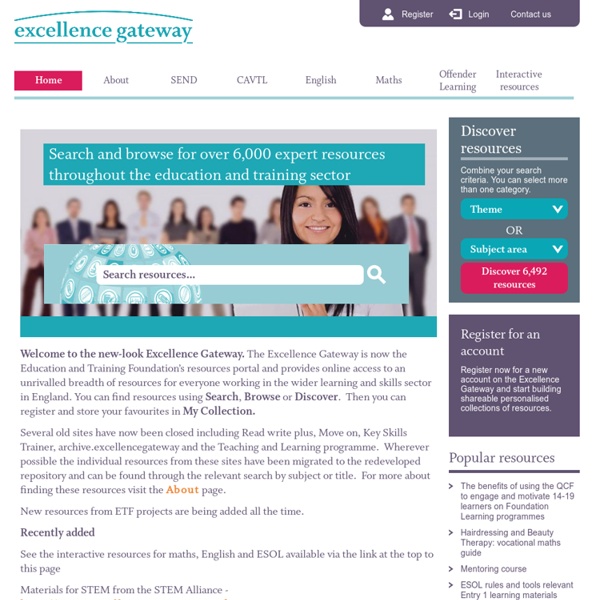



http://www.excellencegateway.org.uk/homepage
Related: class managementTeacher? – appear.in – one click video conversations Learning how to communicate is one of the core things we learn in school. Whether it's reading words written by others, writing our own opinions, presenting our work or collaborating in a group, students develop their communication skills every day. With new technology, the way we communicate also changes. appear.in lets you communicate in the most natural way; seeing the person you're talking to, hearing their voice and taking in all their body language.
Different Ways to Look at Blooms Taxonomy Helpful things to consider when looking at Bloom's Taxonomy in a different way. Most teachers, whether they are new or a seasoned veteran, are familiar with the concept of Bloom’s Taxonomy. Bloom’s system of classification was developed in the 1950’s and identified six different levels of human thought: knowledge, comprehension, application, analysis, synthesis, and evaluation. These six levels move from the least difficult in complexity (knowledge) to the most difficult (evaluation).
How to create a countdown timer in PowerPoint – tekhnologic Recently, I was asked this question: Is it possible to put something like a timer on .ppt slides showing the time count down? It is possible and there are several ways to do it. Some ways are more complicated than others. Support - The fastest way to carry out formative assessments. Get students to focus and concentrate on class videos You can simply find and play any video from Youtube and students can add comments in a live feed. In addition, you can add questions or multiple-choice quizzes, review on the whiteboard and save the results if you wish. Getting started szociogram, portfólió, szociometria Az oldal feladata: Hosszú távon, megbízható segítséget nyújtani a szociogram, a szociogramok elkészítéséhez mindazoknak, akik szívesen foglalkoznak ezzel, de egy kicsit már unják a kis körök meg a nyilak rajzolgatását. Az eddigi visszajelzések alapján, kb. 3-4 órányi munkát lehet kiváltani a program alkalmazásával. Egy híres programozó, Brian Kernighan egyik szállóigéje szerint: “Hagyd a gépre a piszkos munkát!”.
Write and Improve: An Online writing helper Writing is probably the most difficult area for learners to improve on by themselves. Writing demands an audience and if you have no-one to tell you how successful your efforts are – or not – then you are doomed to repeat your failures into eternity. Cambridge English have, however, just released a beta version of an online, browser based writing helper. Teachers get Basecamp for free Over the years, Basecamp has proven to be very popular with teachers, classrooms, and students. We want to take it to the next level by absorbing the cost and offering it free for teachers to use with their students. We know budgets are tight these days, so hopefully this can help reduce the strain and improve school projects at the same time. Here’s how teachers can get a free Basecamp account. If you already have a Basecamp account which you use for your classroom, just drop us a line at teachers@basecamp.com with your Basecamp username or email address and we’ll make sure you don’t get charged for the account any more.
Xpert OER Commons A Soft Murmur Brainstorming and Voting Amazingly Easy. Free Online Tool RANDOM.ORG - True Random Number Service